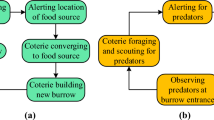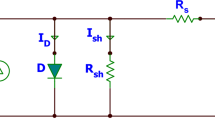Abstract
Solar cell is one of the important renewable energy resources, and it is considered a promising source for energy challenges in the future. The identification of solar cell model parameters is very important due to the control and the simulation of PV systems. In this paper, an enhanced teaching–learning-based optimization (ETLBO) algorithm is proposed and applied to estimate the photovoltaic cells parameter. The ETLBO is proposed to improve the performance of conventional TLBO and reduce its search space by adjusting the parameters which control the explorative and exploitative phases to achieve the suitable balancing. The proposed algorithm is validated using real dataset of photovoltaic single-diode and double-diode models. In addition, the proposed algorithm is tested on the dataset of two real PV panels (polycrystalline and monocrystalline). The results obtained by the proposed algorithm are compared with those obtained by other well-known optimization algorithms. All results prove the effectiveness and superiority of proposed algorithm compared with other optimization techniques.
Graphic Abstract









Similar content being viewed by others
Abbreviations
- I ph :
-
Photogenerated current source
- R S :
-
Series resistance
- R sh :
-
Shunt resistance
- I t :
-
PV module output current
- q :
-
1.602 × 10−19 (C) Coulombs
- I d1 :
-
First diode current
- n 1 :
-
Diffusion diode ideality factor
- I tm :
-
Real dataset current
- T F :
-
Teaching factor
- I sd :
-
Diode rectifier current
- I sh :
-
Shunt resistance current
- V t :
-
Terminal voltage
- T (K°):
-
Photocell temperature (kelvin)
- K :
-
1.380 × 10−23 (J/K°) Boltzmann constant
- I d2 :
-
Second diode current
- n 2 :
-
Recombination diode ideality factor
- I te :
-
Estimated current
- x :
-
Population matrix
- rand:
-
Uniformly distributed random values within range (0, 1)
- PGJAYA:
-
Performance-guided JAYA algorithm
- BFO:
-
Bacterial foraging optimization
- TLABC:
-
Teaching–learning-based artificial bee colony
- ELPSO:
-
Enhanced leader particle swarm optimization
- TVACPSO:
-
Time-varying acceleration coefficients particle swarm optimization
- TLBO:
-
Teaching–learning-based optimization
- SCA:
-
Sine–cosine algorithm
- ETLBO:
-
Enhanced TLBO using SCA
- RMSE:
-
Root-mean-square error
- GOTLBO:
-
Generalized oppositional teaching–learning-based optimization
- BHCS:
-
Biogeography-based heterogeneous cuckoo search
- SATLBO:
-
Self-adaptive TLBO
- WDO:
-
Wind-driven optimization
- GSA:
-
Gravitational search algorithm with linearly decreasing gravitational constant
- SD:
-
Single diode
- DD:
-
Double diode
- PV:
-
Photovoltaic
References
Alam DF, Yousri DA, Eteiba MB (2015) Flower pollination algorithm based solar PV parameter estimation. Energy Convers Manag 101:410–422
Allam D, Yousri DA, Eteiba MB (2016) Parameters extraction of the three diode model for the multi-crystalline solar cell/module using moth-flame optimization algorithm. Energy Convers Manag 123:535–548
Askarzadeh A, Rezazadeh A (2012) Parameter identification for solar cell models using harmony search-based algorithms. Sol Energy 86:3241–3249
Ayala-Mato F, Seuret-Jimenez D, Escobedo-Alatorre JJ, Vigil-Galan O, Coure M (2017) A hybrid method for solar cell parameter estimation. J Renew Sustain Energy 9:063504
Chen X, Yu K (2019) Hybridizing cuckoo search algorithm with biogeography-based optimization for estimating photovoltaic model parameters. Sol Energy 180:192–206
Chen X, Yu K, Du W, Zhao W, Liu G (2016) Parameters identification of solar cell models using generalized oppositional teaching learning based optimization. Energy 99:170–180
Chen X, Xu B, Mei C, Ding Y, Li K (2018) Teaching–learning-based artificial bee colony for solar photovoltaic parameter estimation. Appl Energy 212:1578–1588
Črepinšek M, Liu S-H, Mernik M (2013) Exploration and exploitation in evolutionary algorithms: a survey. ACM Comput Surv (CSUR) 45:35
Guo L, Meng Z, Sun Y, Wang L (2016) Parameter identification and sensitivity analysis of solar cell models with cat swarm optimization algorithm. Energy Convers Manag 108:520–528
Jamadi M, Bayat FM, Bigdeli M (2016) Very accurate parameter estimation of single- and double-diode solar cell models using a modified artificial bee colony algorithm. Int J Energy Environ Eng 7:13–25
Jervase JA, Bourdoucen H, Al-Lawati A (2001) “Solar cell parameter extraction using genetic algorithms. Meas Sci Technol 12:1922–1925
Jiang LL, Maskell DL, Patra JC (2013) Parameter estimation of solar cells and modules using an improved adaptive differential evolution algorithm. Appl Energy 112:185–193
Jordehi AR (2016) Time varying acceleration coefficients particle swarm optimization (TVACPSO): a new optimization algorithm for estimating parameters of PV cells and modules. Energy Convers Manag 129:262–274
Jordehi AR (2017) Gravitational search algorithm with linearly decreasing gravitational constant for parameter estimation of photovoltaic cells. In: 2017 IEEE congress on evolutionary computation (CEC). IEEE
Jordehi AR (2018) Enhanced leader particle swarm optimisation (ELPSO): an efficient algorithm for parameter estimation of photovoltaic (PV) cells and modules. Sol Energy 159:78–87
Kalage AA, Ghawghawe ND (2016) Optimum coordination of directional overcurrent relays using modified adaptive teaching learning based optimization algorithm. Intell Ind Syst 2:55–71
Korashy A, Kamel S, Youssef A-R, Jurado F (2019) Modified water cycle algorithm for optimal direction overcurrent relays coordination. Appl Soft Comput J 74:10–25
Li Y, Huang W, Huang H, Hewitt C, Chen Y, Fang G, Carroll DL (2013) Evaluation of methods to extract parameters from current–voltage characteristics of solar cells. Sol Energy 90:51–57
Mathew D, Rani C, Kumar MR, Wang Y, Binns R, Busawon K (2018) Wind-driven optimization technique for estimation of solar photovoltaic parameters. IEEE J Photovolt 8(1):248–256
Merchaoui M, Sakly A, Mimouni MF (2018) Particle swarm optimization with adaptive mutation strategy for photovoltaic solar cell/module parameter extraction. Energy Convers Manag 175:151–163
Mirjalili S (2016) SCA: a sine cosine algorithm for solving optimization problems. Knowl Based Syst 96:120–133
Nune HGG, Pombo JAN, Mariano SJPS, Calado MRA, Felippe de Souza JAM (2018) A new high performance method for determining the parameters of PV cells and modules based on guaranteed convergence particle swarm optimization. Appl Energy 211:774–791
Oliva D, Cuevas E, Pajares G (2014) Parameter identification of solar cells using artificial bee colony optimization. Energy 72:93–102
Oliva D, Abd El Aziz M, Hassanien A (2017a) Parameter estimation of photovoltaic cells using an improved chaotic whale optimization algorithm. Appl Energy 200:141–154
Oliva D, Ewees AA, Abd El Aziz M, Hassanien AE, Cisneros MP (2017b) A chaotic improved artificial bee colony for parameter estimation of photovoltaic cells. Energies 10:865
Ram JP, Babu TS, Dragicevic T, Rajasekar N (2017) A new hybrid bee pollinator flower pollination algorithm for solar PV parameter estimation. Energy Convers Manag 135:463–476
Rao RV, Savsani VJ, Vakharia D (2011) Teaching–learning-based optimization: a novel method for constrained mechanical design optimization problems. Comput Aided Des 43:303–315
Rao RV, Savsani VJ, Vakharia D (2012) Teaching–learning-based optimization: an optimization method for continuous non-linear large scale problems. Inf Sci 183:1–15
Shi Y, Eberhart RC (1998) Comparison between genetic algorithms and particle swarm optimization. In: 1998 annual conference on evolutionary programming, San Diego
Shi Y, Eberhart RC (1999) Empirical study of particle swarm optimization. In: Proceedings of the 1999 congress on evolutionary computation-CEC99 (Cat. No. 99TH8406). IEEE
Singh M, Panigrahi B, Abhyankar A (2013) Optimal coordination of directional over-current relays using teaching learning-based optimization (TLBO) algorithm. Int J Electr Power Energy Syst 50:33–41
Soon JJ, Low K-S (2012) Photovoltaic model identification using particle swarm optimization with inverse barrier constraint. IEEE Trans Power Electron 27(9):3975–3983
Subudhi B, Pradhan R (2018) Bacterial foraging optimization approach to parameter extraction of a photovoltaic module. IEEE Trans Sustain Energy 9(1):381–389
Tong NT, Pora W (2016) A parameter extraction technique exploiting intrinsic properties of solar cells. Appl Energy 176:104–115
Venkata Rao R, Patel V (2013) An improved teaching–learning-based optimization algorithm for solving unconstrained optimization problems. Sci Iran 20:710–720
Xiao W, Lind MGJ, Dunford WG, Capel A (2006) Real-time identification of optimal operating points in photovoltaic power systems. IEEE Trans Ind Electron 53(4):1017–1026
Xu S, Wang Y (2017) Parameter estimation of photovoltaic modules using a hybrid flower pollination algorithm. Energy Convers Manag 144:53–68
Ye M, Wang X, Xu Y (2009) Parameter extraction of solar cells using particle swarm optimization. J Appl Phys 105:094502
Yu K, Liang JJ, Qu BY, Chen Xu, Wang H (2017a) Parameters identification of photovoltaic models using an improved JAYA optimization algorithm. Energy Convers Manag 150:742–753
Yu K, Chen X, Wang X, Wang Z (2017b) Parameters identification of photovoltaic models using self-adaptive teaching–learning-based optimization. Energy Convers Manag 145:233–246
Yu K, Qu B, Yue C, Ge S, Chen X, Liang J (2019) A performance-guided JAYA algorithm for parameters identification of photovoltaic cell and module. Appl Energy 237:241–257
Zagrouba M, Sellami A, Bouaıcha M, Ksouri M (2010) Identification of PV solar cells and modules parameters using the genetic algorithms: application to maximum power extraction. Sol Energy 84:860–866
Acknowledgements
The authors gratefully acknowledge the contribution of the NSFC (China)-ASRT (Egypt) Joint Research Fund, Project No. 51861145406 for providing partial research funding to the work reported in this research.
Author information
Authors and Affiliations
Corresponding author
Rights and permissions
About this article
Cite this article
Ramadan, A., Kamel, S., Korashy, A. et al. Photovoltaic Cells Parameter Estimation Using an Enhanced Teaching–Learning-Based Optimization Algorithm. Iran J Sci Technol Trans Electr Eng 44, 767–779 (2020). https://doi.org/10.1007/s40998-019-00257-9
Received:
Accepted:
Published:
Issue Date:
DOI: https://doi.org/10.1007/s40998-019-00257-9




